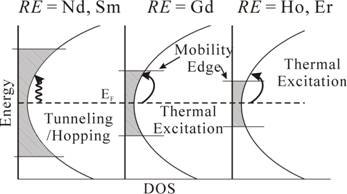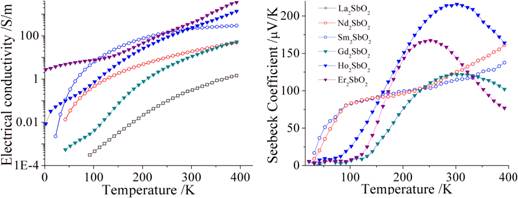57th Annual Report on Research 2012 Under Sponsorship of the ACS Petroleum Research Fund
Reports: DNI1048882-DNI10: Layered Rare-Earth Antimony and Bismuth Suboxides as Novel Thermoelectric Materials
Yurij Mozharivskyj, McMaster University
Objective:
The goal of the ACS-PRF funded project was to prepare novel thermoelectric materials via chemical fusion of semimetallic RESb/REBi and insulating RE2O3 binaries (RE is a rare-earth element). The idea was to structurally combine the RESb/REBi and RE2O3 phases with different properties in order to obtain "electron-crystal phonon-glass" materials with improved thermoelectric performance (Figure 1).
 |
Figure 1. Formation of (RESb)n(RE2O3) from RESb, an "electron crystal", and RE2O3, a "phonon glass".
Results (2011-2012):
1) Decoupling the Electrical Conductivity and Seebeck Coefficient in the RE2SbO2 Compounds through Local Structural Perturbations
Compromise between electrical conductivity and Seebeck coefficient limits the efficiency of chemical doping in the thermoelectric research. An alternative strategy, involving the control of a local crystal structure, is demonstrated to improve the thermoelectric performance in the RE2SbO2 system. The RE2SbO2 phases, adopting a disordered anti-ThCr2Si2 type structure (I4/mmm), were prepared for RE = La, Nd, Sm, Gd, Ho and Er. By traversing the rare-earth series, the lattice parameters of the RE2SbO2 phases are gradually reduced, thus increasing chemical pressure on the Sb environment. As the Sb displacements are perturbed, different charge carrier activation mechanisms dominate the transport properties of these compounds. As a result, the electrical conductivity and Seebeck coefficient are improved simultaneously while the number of charge carriers in the series remains constant. This study illustrates possibilities of overcoming the classical challenges in the thermoelectric research.
Figure 2. DOS at the Fermi level in the middle of a pseudogap. The shaded region represents localized states. The mobility edge is marked at boundary between the localized and the non-localized states. Three charge carrier activation mechanisms are shown: (left) hopping between the localized states; (center) thermal activation into localized states (RE = Gd); (right) thermal activation into non-localized states (RE = Ho, Er).
Figure 3. Electrical conductivity and Seebeck coefficient for the RE2SbO2 phases.
2) Disorder-Controlled Electron Transport Properties in the Ho2Sb1-xBixO2 Systems
The Ho2Sb1-xBixO2 series was traversed by varying the Sb:Bi ratio. While the modification on the average Ho2Sb1-xBixO2 structure is minimal, the lattice disorder caused by the pnictogen atomic displacement is reduced upon the Bi substitution. As a result, the energy range of Anderson-type localization within the Sb/Bi states diminishes. Since the Sb/Bi states dominated the electronic structure at the vicinity of the Fermi level, the electrical properties of the Ho2Sb1-xBixO2 phases were altered systematically within a large range. With this study, we proved that the electrical properties of a disordered system can be tuned by controlling the degree of atomic localization. In a suitable system, such indirect physical property perturbation may be used in conjunctions with other methods such as chemical doping and superlattice construction to produce tailor-made materials for the future electronic and optical applications.
Figure 4. Electrical conductivities (a) and Seebeck coefficents (b) of the Ho2Sb1-xBixO2 compounds in the rage of 0–400K.













